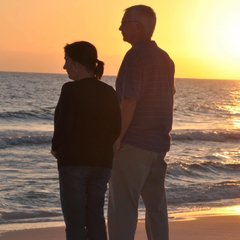Leaderboard
Popular Content
Showing content with the highest reputation on 11/09/2018 in all areas
-
John - Sorry for waiting so long to get back to your questions but I had imagined that some of our true gearheads would have jumped on these questions by now. Having had some wheel bearing problems in the past, I'm a bit on the conservative side with regards to the care of these puppies. My answers to your questions: A. No B. At 8,000 miles, plus some time sitting plus probably near a year since the bearing were serviced you should get your bearings serviced. C. No inspection ports. D. Yes - pull the drum. No unless there is evidence that the rear seal is suspect (i.e. grease on the wrong side of the seal or obvious other problems). E. I have had no failures on my Oliver but have had failures with previous trailers. The failures were due to bad bearings and not due to regular service. F. No. G. Mine are wearing evenly and still have more than half life left after three years of towing and over 30,000 miles. There are all kinds of reasons as to why your bearings just might still be in very good shape (no load during storage, dry enclosed storage facility, even with 8,000 miles if they were "easy" miles with little water/rain or dusty roads, etc.). My last service two months ago showed that even at 10,000 miles my seals and grease still looked very good even though I did a bunch of Interstate miles with temps in the 90's and also did a bunch of driving down very dusty dirt roads. However, the question I always ask myself - is the saving of those service dollars worth the risk? Bill1 point
-
Hi John Please excuse my slow response. I don’t check in here regularly. A and B: I have 2017 chassis 244, which does not have the EZ Lube spindle connectors that would allow a bearing “flush” with fresh grease. I formerly owned a Casita that did have the EZ Lube design. I think that the 2018 Oliver models do not have the EZ Lube spindles. C. Backing plates on my wheels have two oblong openings at the bottom that are used for adjusting the brake shoe “star” cluster. I don’t think that you can visualize the shoe wear through these holes. There is a small circular hole (~1 cm diameter) at the top of the backing plate. I’m not sure if this can be used to visualize the brake shoe wear either. Maybe someone else can clarify. D. In the wheel bearing lubrication section of the Oliver manual, no mention is made of replacing the inner bearing seal if the hub is removed. E. I repacked my bearings recently at nearly 10,000 miles and noticed no uneven wear on any of the bearings or spindles. Similarly, there was no excessive or uneven wear on any of the brake shoes. Hope this helps, Bob G1 point
-
Standard water heater for us. You will learn when to shut off the water heater. Standard toilet is great. Dumping occasionally is no big deal. Especially if you are use to the lifestyle. Camera. Ours from the factory is about 7 1/2" on the monitor. It is so nice when passing, you can see when ton pull back in. You can bring the monitor in at night or when camped and have a security cam. Have a cam put on the front and you can see what is going on on that end as there are no windows too. Welcome, but if they find out there is an Oliver in Alaska, they will all come to visit...1 point
-
Good solution, John. But, if you decide on the waterless composting toilet, you can still collect the water and heat in a tea kettle for dishwashing and hand laundry..... Besides the price, the roughly 6 inch height difference in the nature's head toilet and the standard RV toilet would be problematic for some of us shorter people, though I'm a big fan of the concept. Might improve winter camping possibilities, imo. However, we've only used the flush toilet and black and grey for 11 years, without issue. Never had the composting toilet. We've had both types of water heaters, and we camp without electricity or hookups most of the time. Topgun's described method of heating shower water to a comfortable temp only is wise, and used by quite a few folks. Heating dishwater in a teakettle not only saves propane, but cuts water use by making you keenly aware of how much water you are using for the task. We replaced the standard 6 gallon with a Girard instantaneous a few years ago, when our water heater died. We like it. But, you may be just as happy with the included 6 gallon... which also had the advantage of running on electricity when you have it. I don't think the Truma runs on dual fuel. I know our girard is lp only.. As far as generators, I'd look around at a few more choices. There's a gen set thread running now that offers more ideas and opinions... Are you getting solar? Do you really need a generator for anything more than charging the batteries occasionally? There's a lot to choose from. And, you may not want to start with something so very large and heavy, right off the bat. Good luck. So many options. My decision would include those items most expensive and difficult to add later, balancing against the budget. Water heater is an easy upgrade, for example. Sherry1 point
-
Jaque: Welcome to the Oliver Family and our Forum. An item not yet commented upon is your concern with not wasting water while boondocking. Spot on! Solution: Cut the top of a plastic milk jug above the handle in an oval shape towards the opposite side so that the sink faucet handle/shower head can slip into the jug but leaving the jug handle intact. When you want hot water at the bathroom or kitchen, use the jug to collect the cold "Hot water". Place it by the toilet for future flushing. I also encourage you to scour the Forum and Oliver University sections of this site. The owners and OTT have an amazing amount of info on line that is invaluable. John TOM: Thanks for the reminder that the hot water heater indirectly also assists in keeping the inner hull space warm. I had not thought of that before your post. Mahalo!1 point
-
Composting toilet - just buy it, you will fall in love with it. Put all paper products into a small 3 gallon flip lid wastebasket. It fits neatly between toilet and vanity. Spritz the front bowl area two or three squirts after peeing. The vinegar kills the odor and rinses the bowl. Poo is not an issue, normally it drops straight down onto the compost. If you get the runs your toilet will not like that. For your height issue, there is a floor ledge that sticks out in front of the base. Climb up, set your feet there and no worries. Or you can get a small step and stash it behind the toilet when not in use. My wife is 5'6" and has no problems. For a boondocker the NH toilet is simply wonderful, just get used to the quirks. Not having to find an open dump station and wait for fifteen minutes is priceless. If you camp off season, this is a huge factor since many close down when freezing night time weather arrives. Around here that means late October. Plus it saves a bunch of your potable water. If you decide that you hate it, sell it on Craigslist for $400 and buy a flush toilet. All the plumbing and the tank is in place. Installation of a standard RV toilet would be very simple. Camera; you NEED a backup camera when solo, no question. It is not just for backing into a site. It is useful in heavy traffic too. You might want to invest in a different system. I already use and really like the Garmin RV660 gps and I mounted a Garmin backup camera. The gps will accept up to four wireless camera inputs. Resolution is low but entirely adequate. ... https://support.garmin.com/en-US/?faq=w0sjNmRQFR3N58uLaMpMR8 http://olivertraveltrailers.com/topic/how-to-install-a-garmin-bc-30-backup-camera/ Hot water heater: get the standard unit, leave it turned off until you need some hot water. Turn it on for fifteen or twenty minutes and it heats up enough for one person. It is cheap to replace or service and is generally very reliable. We just run ours 24/7. It does not use that much propane and we have the big gas tanks.... if we do plug in, it switches over the shore power if the outside switch near the bottom is turned to "ON". John Davies Spokane WA1 point
-
Jaque - I hated the part of ordering that you are going through now. So many choices and trying to think of all the possibilities versus the monies being spent. I went with the standard toilet. I too travel much of the time solo. When not boondocking there are virtually always toilets nearby for poo. When boondocking I have a shower tent and a collapsible toilet that uses those bags Heather mentioned. That system works great, uses no "on-board" water and is easily disposed of. On long trips, I do carry a small "blue" portable tank in the event I need to make more room in the black tank - just be careful to not put too much "stuff" in the portable tank so that I can lift it to a regular toilet for emptying if necessary. While intriguing, I found the composting toilet to be expensive and uncomfortable versus the benefits. I didn't go with the factory camera system for two reasons. First, I thought that it was a bit expensive. Second, I simply didn't want another screen in the cockpit of my truck. At delivery I added a small camera located in the upper half of the spare tire cover that transmits signal via WiFi to my tablet or phone. It works great except for when it rains - the camera picks up too much road spray to see tailgaters. The water heater is another one of those return for the money things. Basically $1,000 for instant gratification? Like KountryKamper, I too believe that the winterization is no big deal and servicing while on the road is easier. For small things like dishes, I simply heat water in a pot on the stove. For showers I almost always use a solar shower and the shower tent I mentioned above. This is a great way to save water, room in your grey tank and propane that would have been used to heat the water. When I really do need to use the shower in the camper I do not allow the water heater to heat the water to its maximum. I posted a thread some time ago on my system of using a meat thermometer with remote readout to monitor the water heater temperature and turn off the heater when it hits about 106 degrees. Then when taking a shower I do not need to mix cold water with the hot to get the correct temp and I can take a shower easily before the water starts getting too cold. I will edit this post if I can find a link to that thread. Finally, I'm no help to you regarding the generator. Almost always when I have needed air conditioning I have been able to use a campground that had electric hookup. Even camping this summer out West when daytime temperatures hit highs of 108 degrees, the lack of humidity plus the decline in temps overnight provided easy sleeping. Other than that the solar panels kept my batteries fully charged each day. Good luck on these "final" decisions of yours. Either way you decide on virtually any of the options, I'm sure that you will be happy with your Oliver. These campers are just so easy to travel with. Bill1 point
-
The standard heater will give off some heat and will help keep the area between the hulls warm in cold weather. It is also easier to find someone that knows how to work on it and find parts if something goes wrong. You just pull the anode rod to winterize which is not a big deal.1 point
-
I went with the compost - with some experience under our belt, I'd go that way again. Yes it is a little work, setting it up, and eventually emptying it, but the black tank thing is about the same, and you don't use any of you water. The height can be solved with a simple step up "platform", and the dc fan uses little energy. I unplug it when the toilet is not "composting" (empty). We haven't had an issue separating the 1s and 2s. Keep a small spray bottle with some vinegar for cleanup. I believe in the end it comes down to personal preference - with your experience with rocket boxes, it shouldn't be a big deal. I went with the Truma - I like it very much. I have had a little experience with it setting a code, but I believe that was my fault - once left the propane off, and the other,, not sure. It is very simple to winterize. Again, probably personal preference. As for the other - I didn't need a camera, and generators - are like people, all kinds to choose from. Good to have another Ollie owner, wishing you well in your purchase and future travels.1 point
-
geO, This is interesting. On my 2015, all the windows, maxxair vent, bathroom fan, plumbing vent, and all the other penetrations were factory sealed with 3M Fast Cure 4000 UV. Oliver uses this all over the trailer inside and out. The porch lights and the markers were factory sealed with silicone. Many of those sealed with the silicone have failed. I would not use silicone over the 3M 4000. I had a few gaps here and there in the window trim that I redid. And I also cleaned up some "less than adequate" joints on the interior, especially in the bathroom and around the kitchen sink. The only issue with the 3M 4000, other than it's cost, is that once opened, it has a very short shelf life. So get all your spots lined up and do the inside and outside all at once. Cut the tip on your tube sparingly! Clean your rig well to remove any dirt and wax. Give a quick pre-wipe with acetone or MEK (my preference) on a rag around where the joint is. On the inside, I then tape both sides of the joint with thin blue tape (delicate surfaces). Carefully squeeze a fine bead in the joint and smooth out with your finger. Immediately pull the tape and lightly swipe again to get the ridges from the tape to blend in. You may not like to, but I wipe a little paint thinner on my finger to lubricate it a bit, works good. Too much sealant in the joint and you'll have a mess. Use the sealant sparingly. The first wipe should be tight to the tape edge, not going over the top. It's a judgement call depending on the size of the fill. The 3M 4000 can clean up with paint thinner so if there is some that gets away from you, you can carefully clean up with that. The stuff skins over pretty fast so be organized, work small areas, and don't forget to breathe! On the outside, I just very carefully apply the bead and smooth it out with my finger. If the sealant line gets messy, some thinner on a rag drawn along the edge of the sealant cleans it up nicely. Warning though: don't use thinner or any other solvent around your chromed plastic light fixtures, it will mess up the finish! I don't know why Oliver recommended silicone to you when most of what you'll be sealing was done with the 3M product. Good luck! RE: the marker lights, I would like to hear how others have sealed those as I think I have a few leakers, and yes they were factory sealed with silicone! Can the chromed escutcheon ring be removed somehow for sealing? Dave1 point
-
Recent Achievements












